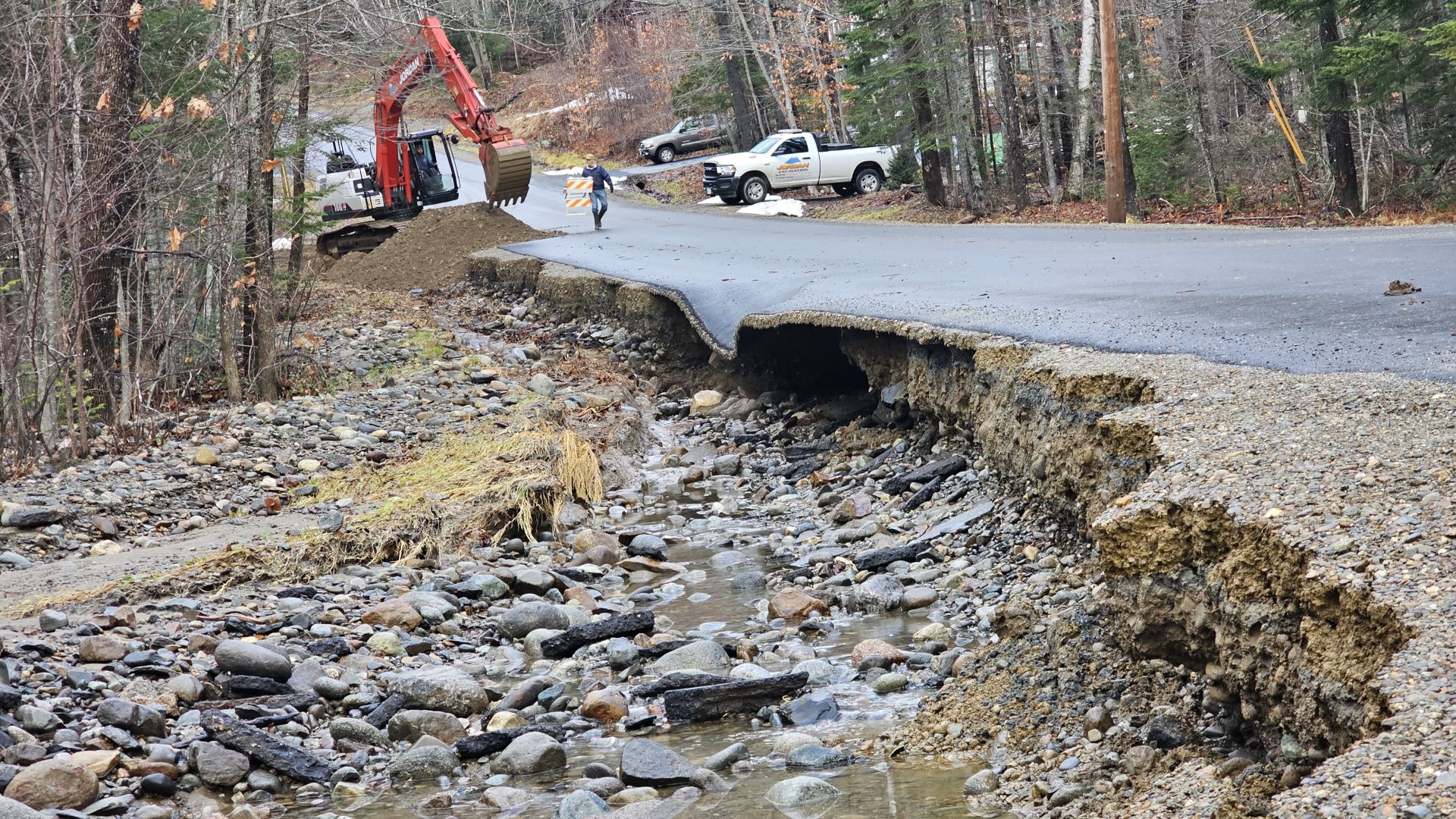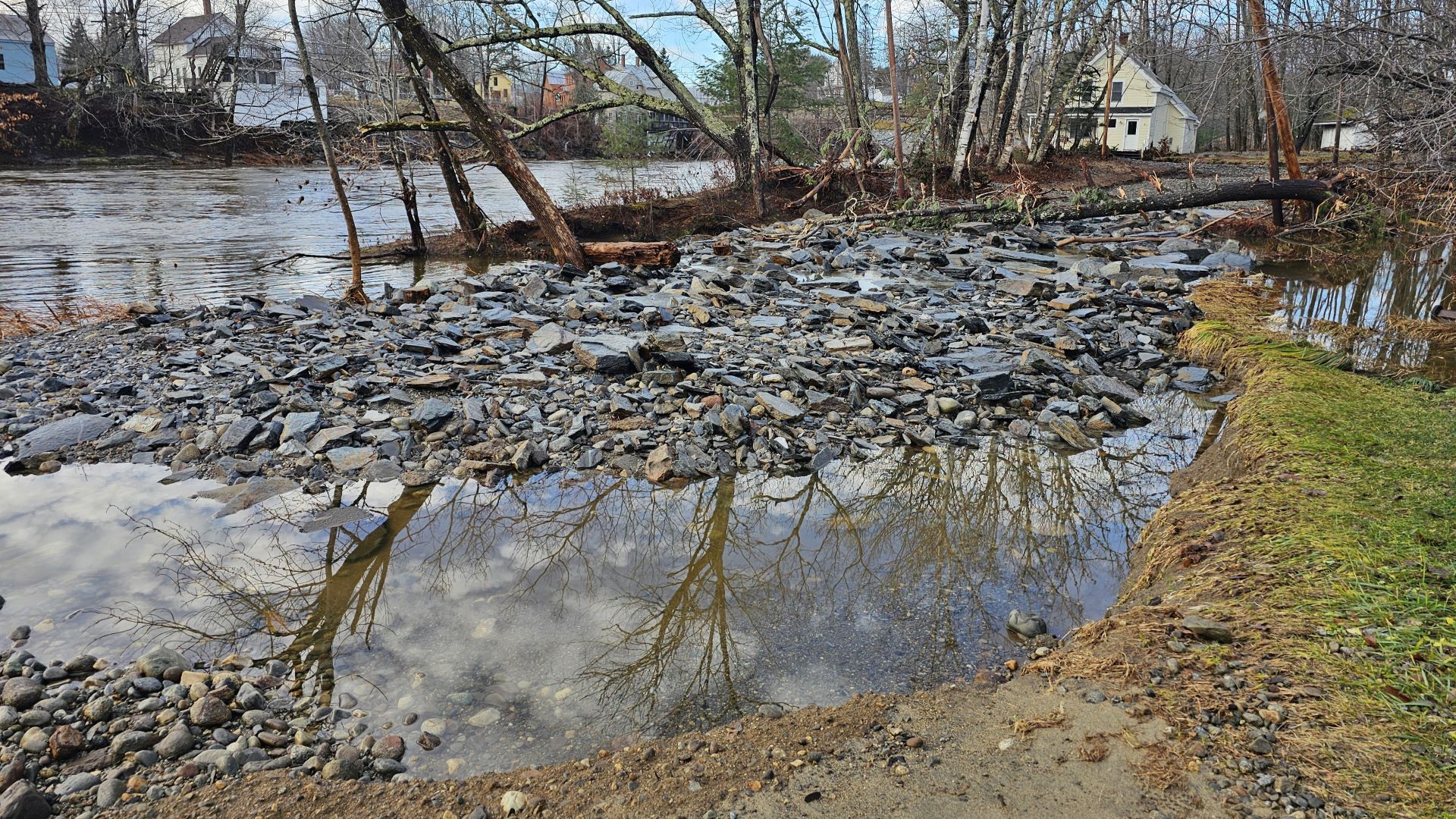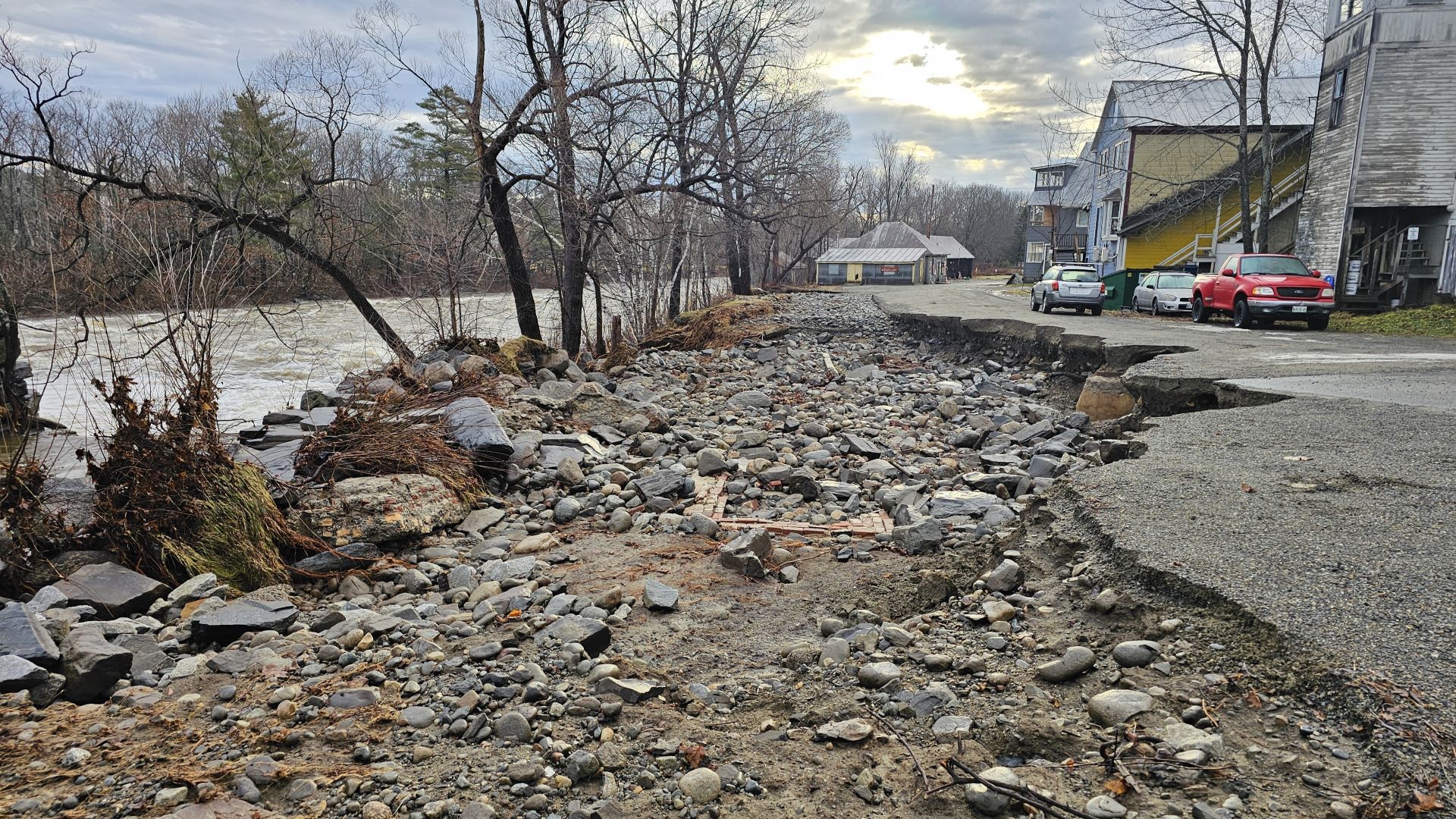Jay Town Manager Shiloh LaFreniere was blindsided when a flood clipped the winding roads of her small valley community in May 2023. But as flood waters receded, a new challenge for LaFreniere arose: navigating a federal disaster assistance application for her first time.
“The amount of paperwork, verification, documentation: It just goes on and on and on,” LaFreniere told The Maine Monitor.
While the town was still picking up the pieces from the May flood a series of violent thunderstorms developed in western Maine, creeping slowly through the mountains. When the storms reached Jay on June 29, they lingered, barraging the area with up to 5 inches of rain and flooding the Androscoggin River and its tributaries.
More than ten Jay roads were decimated, stranding 30 residents in the immediate aftermath. Several were out of commission for months.
The damage to town infrastructure totaled over $4 million. In December 2023 LaFreniere found the town facing yet another federal disaster assistance application, the third disaster to strike Jay in less than eight months.
Luckily the town’s public works director was familiar with the FEMA disaster assistance process and helped guide her through it, LaFreniere said, expertise that smaller Maine municipalities lack.
“I know there are a lot of communities that, when they go through (federal disaster assistance applications), just kind of throw up their hands and say, ‘It’s too much. We can’t do it.’”
Maine lawmakers on Thursday heard overwhelming support for a bipartisan bill that would address some of LaFreniere’s concerns by bolstering the state’s disaster preparedness efforts and providing millions of dollars in grants to fortify Maine homes and local infrastructure against climate change-fueled storms.
The bill, L.D. 1, is sponsored by Democratic and Republican leadership on behalf of Gov. Janet Mills and was received warmly by members of both parties at a Thursday public hearing.
The bill would create three new initiatives, largely in response to the recommendations of a state climate resilience commission, whose members (including LaFreniere) studied the fallout from last winter’s widespread flooding damage and urged the state to improve emergency communications, help small Maine communities navigate federal disaster assistance and buttress homes and infrastructure before the next disaster strikes.
The first initiative, the Home Resiliency Program, operated by the Bureau of Insurance, would offer grants of up to $15,000 to homeowners for roof fortification and floodproofing projects to make their homes more resistant to damage from severe weather events. The legislation would also create a State Resilience Office within the Maine Office of Community Affairs, funded through a five-year federal grant.
The third initiative would focus on supporting Maine’s Emergency Management Agency by establishing a new state fund with $750,000 matching funds to leverage the Federal Emergency Management Agency’s “Safeguarding Tomorrow through On-going Risk Mitigation Revolving Loan Fund.” It would also add $10 million in the State Disaster Recovery Fund for matching to secure other federal dollars and dedicate $800,000 to improve the state’s emergency communications systems. The bill would not require any general funds.

Lawmakers and representatives of the insurance industry spent the most time mulling over the first initiative, the Home Resiliency Program, at the Thursday hearing. The program would be funded by a one-time transfer of $15 million from the Department of Professional and Financial Regulation, tapping into a pot of revenue from licensing fees charged to insurance agents and dealers operating outside of Maine.
After Insurance Bureau Superintendent Bob Carey testified in support of the bill, members of the Housing and Economic Development Committee clarified which homeowners would be eligible for the grants and questioned how the Bureau of Insurance would protect grantees from poor contracting work.
Carey responded that the state would do its best to publicize the grant across Maine, predicting that the program would first roll out in western and eastern Maine counties and would require specially certified contractors to complete the projects.
To spread the $15 million fund out equitably, Carey proposed amending the bill to cap grant awards on a sliding, income-based scale, potentially limiting wealthier full-time Maine residents to $10,000 while offering lower income homeowners up to $20,000. That could result in assistance for more than 1,000 homeowners, Carey said.
Charles Soltan, an attorney representing the Maine Association of Insurance Companies, a consortium of in-state insurance companies, spoke in support of the bill. However, he and a separate attorney representing an association of Maine insurance agents who opposed the bill both raised concerns about how the Home Resiliency Program’s $15 million would be budgeted in the future. They stated that the bill doesn’t limit how much funding the Bureau of Insurance can draw from its licensing fee fund, which comes from the pockets of the insurance industry.
“The spigot of our fee money that’s also built into rates is not going to be necessarily turned off and we have a concern about that,” Soltan told lawmakers.
The second initiative, the State Resilience Office within the Maine Office of Community Affairs, would be funded through a five-year federal grant. The office would support flood and storm damage prevention and public safety. In the future, the office would require an annual transfer of available balances from the Bureau of Insurance to the State Resilience Fund.
That federal funding, however, comes from a multi-million dollar grant from the National Oceanic and Atmospheric Administration that could fall victim to the massive spending cuts implemented by the Trump administration.
The New York Times reported earlier this month that administration officials informed NOAA staff members to search their grants for terms that include phrases like “climate science” and “environmental quality,” sparking concern among lawmakers and former NOAA officials that those grants are at risk.
Responding to questions from The Maine Monitor about the future stability of that grant, Jackie Farwell, a spokesperson for the Governor’s Office of Policy Innovation and the Future, said the state has been drawing on the grant and that its funds are legally committed to Maine.
“The grant, which was supported by Maine’s full congressional delegation, is legally obligated to the state,” the administration said in a statement.

County emergency management officials and others criticized the bill for not specifically designating county governments as recipients for state assistance, despite their overall support. They implored legislators to add language that specifically identifies counties as assistance recipients.
“The current bill that you have before you does not include counties as an entity at all,” said Arthur Cleaves, director of the York County Emergency Management Agency and a veteran of both state and federal emergency management agencies.
Their recommendation will be one of many that the committee considers during a workshop on the bill, the next stop for the legislation.
“If there’s one thing that my experience has taught me,” said Cleaves, “it’s that all emergencies happen at the local level.”
Bill sponsor Senate President Mattie Daughtry (D-Cumberland) said it’s more urgent than ever for Maine to strengthen its resilience initiatives before future storms strike the state.
The state needs to “prepare, not repair,” Daughtry told her colleagues at the Thursday hearing.
Daughtry’s remarks were followed by one of her co-sponsors, House Minority Leader Billy Bob Faulkingham (R-Winter Harbor), who recalled the destruction that the winter storms wreaked on coastal communities in his district, washing away wharves and causeways and dealing a blow to the local economy.
“L.D. 1 won’t stop storms like this in the future, but it will help towns, businesses and homeowners and their communities be better prepared,” Faulkingham said.







